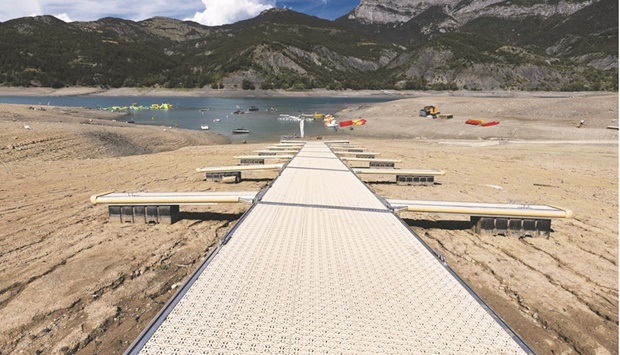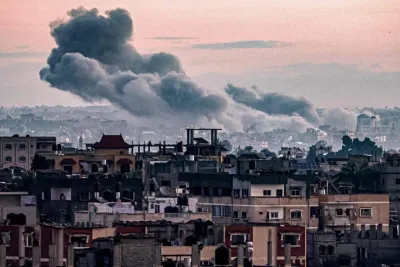A severe drought hitting swathes of Europe is “worsening” and, while rain is helping some regions, accompanying thunderstorms are causing their own damage, EU researchers said in a report yesterday.
The latest monthly analysis by the European Union’s Global Drought Observatory (GDO) highlighted the risk of ongoing soil dryness caused by successive heatwaves since May and a “persistent lack” of rainfall.
It maintained its warning issued with the previous report that nearly half of the EU’s territory is at risk of drought, and noted that shrivelling rivers and shrinking water sources are impacting energy generation at power plants and reducing crops.
“The severe drought affecting many regions of Europe since the beginning of the year has been further expanding and worsening as of early August,” said the report, published by the European Commission’s Joint Research Centre.
Increasing “drought hazard” was predicted for big chunks of Italy, Spain, Portugal, France, Germany, the Netherlands, Belgium, Ireland, Luxembourg, Romania and Hungary, as well as non-EU countries Britain, Serbia, Ukraine and Moldova.
In all, it calculated that 17% of Europe was now in its red-alert category, higher than the 11% given in July.
“Recent precipitation (mid-August) may have alleviated drought conditions in some regions of Europe. However, in some areas, associated thunderstorms caused damages, losses, and may have limited the beneficial effects of precipitation,” it said.
Mediterranean parts of the EU should expect “warmer and drier than usual conditions” up to November, it said.
Regions hit with rain “anomalies” in the past three months included parts of Portugal, Spain, southern France, central Italy, Switzerland, southern Germany and much of Ukraine.
The GDO report said that normal levels of rain were likely to now come to parts of Europe between August and October but they “may not be enough to fully recover from the deficit cumulated in more than half a year”.
Parts of Spain, Portugal and Croatia may continue to suffer “drier than normal weather conditions” however, while dry conditions in the Alps were likely to ease.
The report said that atmospheric conditions linked to the sort of heatwaves baking Europe were, over May, June and July, at their highest since 1950.
Forest fires raging south of Moscow have intensified, Russian authorities said yesterday, as residents of the capital complained of a sharp smell of smoke pervading the air.
Since early August fires have been raging across the Ryazan region, some 200km (125 miles) southeast of Moscow, where officials have been scrambling personnel to put them out.
The region’s acting governor Pavel Malkov said a state of emergency had been put in place and that residents in two settlements – Olgino and Golovanovo – had been ordered to evacuate.
“The area covered by the fire continues to grow slowly. According to the Aerial Forest Protection Service, we are looking at about 8,000-9,000 hectares today,” he said, describing the situation as “tense”.
Temperatures are expected to climb as high as 32° Celsius (91° Fahrenheit) in Moscow this week.
The Russian capital recorded its highest temperature, 38.2C (100.8F), in 2010 when a massive forest fire covered the city in a thick layer of smog.
Wildfires have intensified in Russia in recent years due to hotter weather caused by climate change.
Environmentalists fear that fires and high temperatures could thaw the Siberian permafrost and peatlands, releasing carbon that has been stored in the frozen tundra.
Spain’s government said yesterday it would classify regions struck by big wildfires this year as disaster zones, a move that will trigger emergency subsidies and other financial support measures.
So far Spain has suffered nearly 400 wildfires, following punishing heatwaves and long dry spells, which have devastated more than 287,000 hectares of land, according to the European Forest Fire Information System (EFFIS).
That is more than three times the total area destroyed in 2021, according to the EFFIS database.
Prime Minister Pedro Sanchez said his cabinet would approve classifying as a disaster zone “all territories that have been devastated by the great fires that we have endured throughout this year”.
Parts of Spain are the driest they have been in a thousand years due to an atmospheric high-pressure system driven by climate change, according to a study published last month in the journal, Nature Geoscience.
Portugal, hit by a third heatwave after weeks of wildfires, was on a 24-hour national alert yesterday to counter the threat posed by more blazes.
Under its measures, the authorities have restricted access forests and banned fireworks displays, as well as stepping up the state of readiness of the emergency services.
Having only just brought under control a fire that destroyed more than 28,000 hectares (69,000 acres) in the Serra da Estrela national park, civil protection authorities said firefighters were tackling another blaze in the central northern Vila Real region.

Boarding pontoons on lake Serre-Poncon in Ubaye Serre-Poncon in the French Alps are seen as the water level decreased due to the drought.


